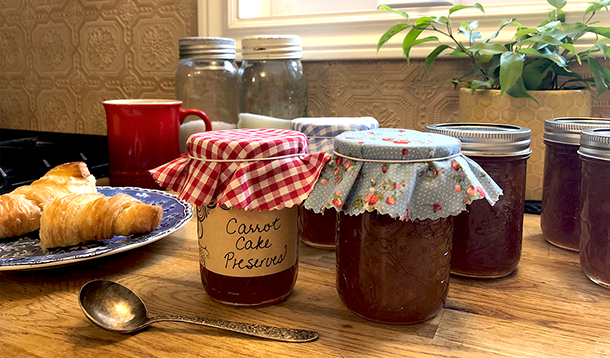
There so many ways to “get your bliss on,” today that it’s become an entire industry unto itself. There’s yoga, guided meditation, relaxation apps, silent retreats, and – I swear I am not making this up – “forest bathing;” a pursuit where one goes on a walk through a forest to purify the spirit. It sounds great, but would you pay $250 for it? And, the best you can hope after on a forest bathing excursion is a seed and nut bar in “Corrugated Cardboard” flavour, and a full body tick check from a stranger in a mosquito hat. We have a better idea for bringing bliss into your life, and it’s just as relaxing as any of the aforementioned pursuits. You will feel as contented – if not more – and there’s a bonus payoff: JAM.

Canning foods like homemade jams, jellies, pickles, and butters (and beyond!) is so calming - and a whole lot easier than you’ve probably been led to imagine. From gathering your ingredients and the necessary supplies, to cleaning, prep and packing, canning is a unique food experience in that you fully participate in a “field to table” way like no other food prep method. Canning gives you a real hand in how you feed your family. Read the recipe below and now sit for a second or two and imagine how amazing this jam is going to be, served on rolls with cream cheese at a sunny breakfast table next weekend. That feeling you’re getting? That’s bliss.
It’s likely you’d never before considered canning to be something that’d cleanse your mind of the worries that seem to collect there, but hear us out: When you are canning, you are in the moment. Every step is laid out, and the process is a 1,2,3 style chronology. No more “1 to 2 to 14 and back to 12 again”, like almost anything else you try to get accomplished during hurried and harried days. Bernardin makes canning your own delicious preserved foods easy. And canning foods does not mean you need to have a back-40 acre garden (but if you do, that’s great, too!) And, contrary to popular legend, canning is not a gateway drug to owning an alpaca farm and weaving your own toilet paper.
Canning is so incredibly doable and you are going to be amazed at how easy the process can be. It is zen-like in a way that you need to feel to believe, and I swear, the moment you hear those jam jar lids pop-pop-popping on your counter top in the afternoon sunshine, you are going to be so contented that you may even have a mini “alpaca farm” fantasy right there at the sink. Go with it. This is ME time.
Ingredients
Directions
• Place 8 clean 250 ml mason jars on a rack in a boiling water canner; cover jars with water and heat to a simmer (180°F/82°C). Set screw bands aside. SNAP LID sealing discs in hot water, not boiling (180°F/82°C). Keep jars and sealing discs hot until ready to use.

• In a large, deep stainless steel saucepan, combine carrots, pears, pineapple with juice, lemon juice, cinnamon, nutmeg and cloves. Bring to a boil over high heat, stirring frequently. Reduce heat, cover and boil gently for 20 minutes, stirring occasionally. Remove from heat and whisk in pectin and 1/2 tsp (2 ml) butter or margarine to reduce foaming, until dissolved. Bring to a boil over high heat, stirring frequently. Add sugar all at once and return to a full rolling boil, stirring constantly. Boil hard, stirring constantly, for 1 minute. Remove from heat and skim off foam.

• Ladle hot jam into a hot jar to within 1/4 inch (0.5 cm) of top of jar (headspace). Using nonmetallic utensil, remove air bubbles and adjust headspace, if required, by adding more jam. Wipe jar rim removing any food residue. Centre hot sealng disc on clean jar rim. Screw band down until resistance is met, then increase to fingertip tight. Return filled jar to rack in canner. Repeat for remaining jam.

• When canner is filled, ensure that all jars are covered by at least one inch (2.5 cm) of water. Cover canner and bring water to full rolling boil before starting to count processing time. At altitudes up to 1000 ft (305 m), process – boil filled jars – 10 minutes.
• When processing time is complete, turn stove off, remove canner lid, wait 5 minutes, then remove jars without tilting and place them upright on a protected work surface. Cool upright, undisturbed 24 hours; DO NOT RETIGHTEN screw bands.
• After cooling check jar seals. Sealed lids curve downward and do not move when pressed. Remove screw bands; wipe and dry bands and jars. Store screw bands separately or replace loosely on jars, as desired. Label and store jars in a cool, dark place. For best quality, use home canned foods within one year.

You can also share the joy; invite friends and family over for a canning party. If you each prepare different recipes, you'll reap even more reward by getting a two-for-one deal. It's once the make, twice the take - and that's the best kind of math.
There’s only one thing you need to be warned about, because bliss in the kitchen can be addictive: Give your friends the heads up to clear spaces in their pantries this upcoming harvest season. Because now that you’ve conquered jam, you’re going to be unstoppable.
You hear that, pickles? We’re coming for ya.


This is proudly sponsored by our friends at Bernardin.